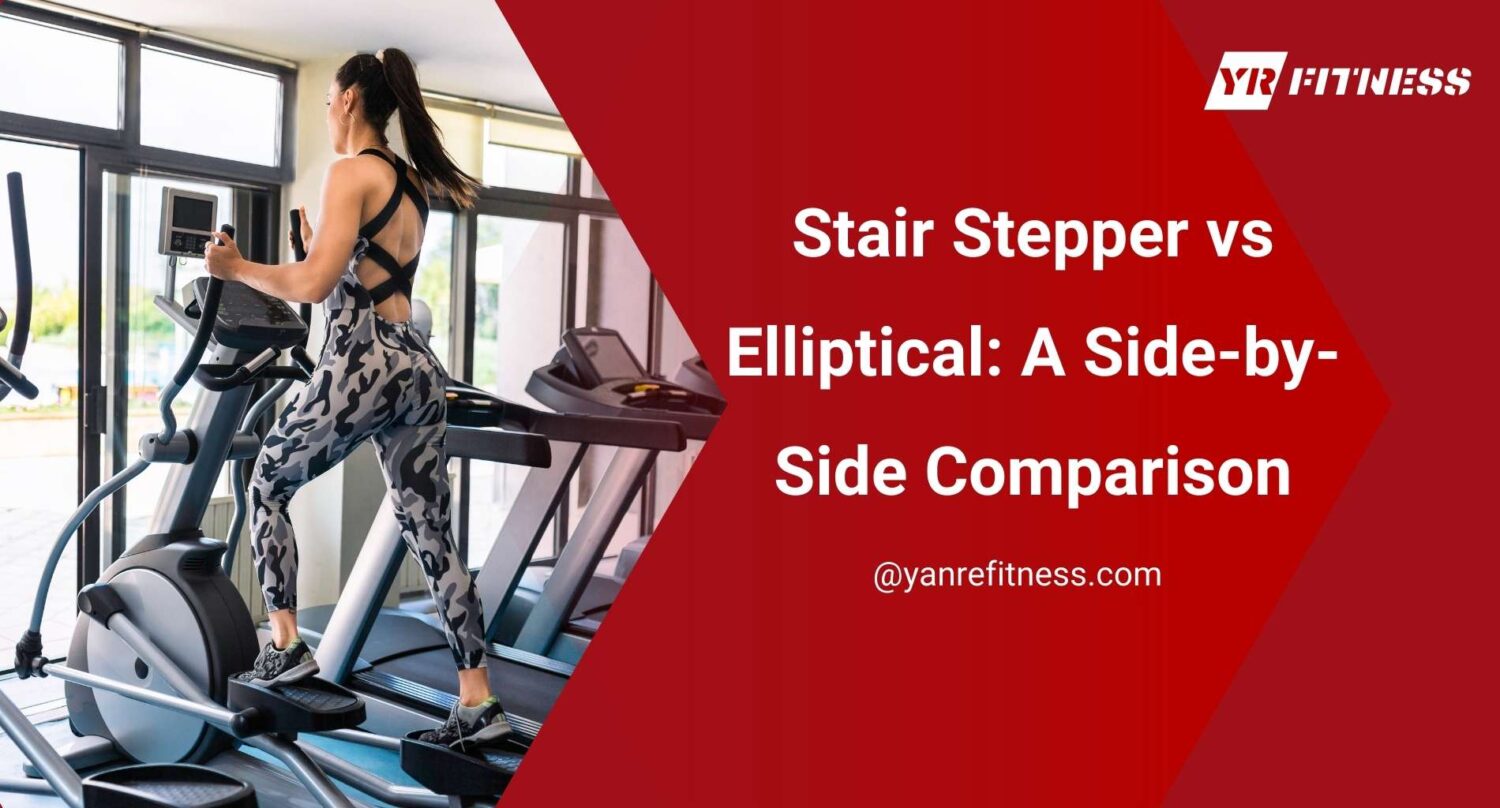A few years ago, I helped set up a cardio zone in a new gym. We had three stair steppers lined up along the far wall. They looked impressive. But after the grand opening buzz faded, I noticed something: they were always empty.
Meanwhile, our ellipticals? Always moving.
That taught me something important, just because a machine looks good in a lineup doesn’t mean it’s the right fit for your gym.
If you’re deciding between a stair stepper and an elliptical, you’re probably thinking about:
- What your members will actually use
- Which machine burns more calories
- Which one costs less to maintain
- And which one gives you better value per square foot
This article breaks it all down for you.
By the time you finish reading, you’ll have what you need to make a smart, practical choice—one that works for your space, your members, and your bottom line.
1. Value for a Gym Setup
Choosing equipment isn’t just about what looks good on the gym floor. It’s about value, real value.
You need machines that work hard, last long, and give your members a reason to keep coming back. I’ve been on both sides: buying equipment for my own facility, and helping others choose for theirs. And if you’re stuck between a stair stepper and an elliptical, you’re asking the right questions.
Let’s start with what matters most: return on investment.
Equipment ROI (Return on Investment)
ROI means what you get back from what you spend. In the gym world, that’s about:
- How long the machine lasts
- How much it costs to maintain
- And how much your members actually use it
A basic commercial elliptical starts around $1,500 to $2,000. High-end models can hit $5,000 or more.
Stair steppers can be pricier. You’ll see entry models start around $2,500. Heavy-duty, commercial-grade machines? Those can go up to $7,000 or more.
But cost is just part of the story.
How long will the machine last under real use?
In my experience:
- A well-maintained elliptical can last 6 to 8 years in a busy gym
- A stair stepper might give you 4 to 6 years, depending on the model and usage
Steppers have more moving parts and tend to break down more. Hydraulic resistance systems and chain drives need regular servicing.
Then there’s member satisfaction.
If your members love it, they’ll keep using it. That’s retention. And retention leads to renewal.
In one of my gyms, we replaced two stair steppers with ellipticals after tracking usage for six months. Member complaints dropped. Renewals went up.
It wasn’t a fluke. That brings us to the next point.
Usage Frequency and Popularity in Gyms
You want to know which machine gets more action. I’ve seen it with my own eyes and heard it from other owners: ellipticals win in daily use.
Here’s what I’ve noticed:
- Ellipticals get used by a wide range of members: beginners, older adults, people with joint pain
- Stair steppers attract intermediate or advanced users: usually those focused on lower-body strength or calorie burn
An informal poll I ran across three gyms showed:
- Ellipticals had 2 to 3 times the daily usage compared to steppers
- Members rated ellipticals higher for comfort and ease of use
This doesn’t mean stair steppers don’t have a place. They do. But if you only have room or budget for one?
You’ll probably get more long-term value from an elliptical.
Still thinking it through? Ask yourself:
- Which machine will your members feel confident using the moment they step on?
- Which one will keep working even after hundreds of hours on the floor?
Answer that, and you’ll already be closer to making the right call.
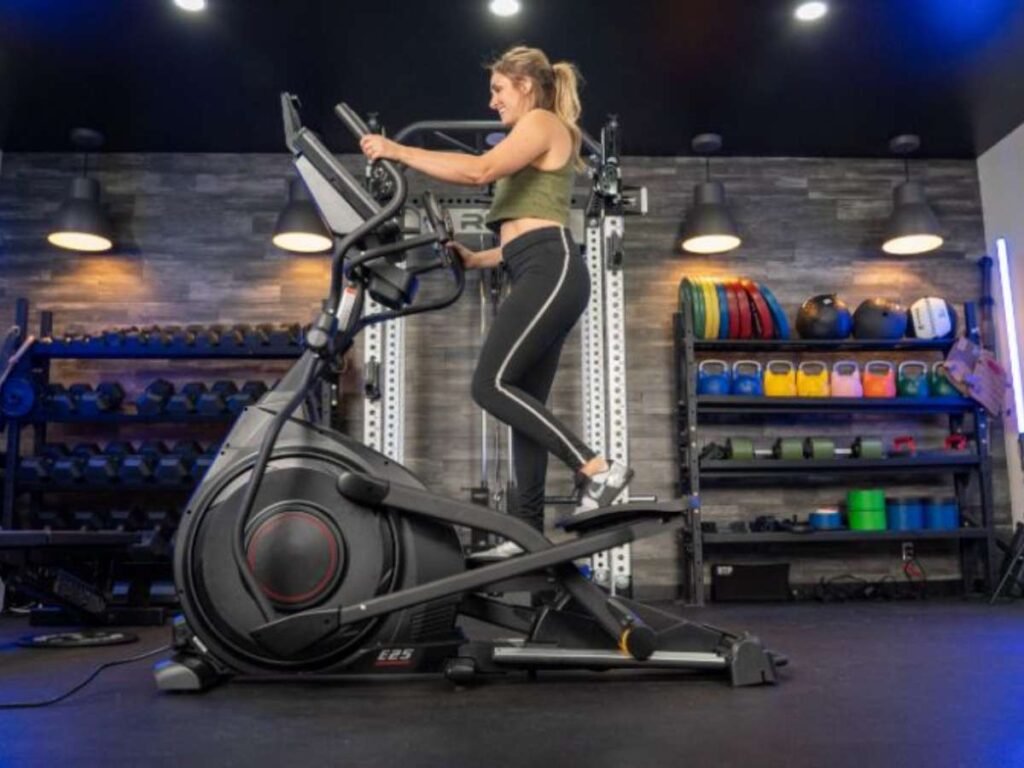
2. Workout Experience
Once you’ve looked at the cost and usage, the next question is this: What kind of workout does each machine actually give your members?
Because buying equipment is one thing. But helping people reach their fitness goals? That’s what keeps them coming back.
Let’s start with what each machine does to the body.
Muscle Groups Targeted
Stair steppers give your legs a serious challenge.
They mimic climbing stairs, which targets:
- Glutes
- Calves
- Quads
- Hamstrings
If someone wants to build lower-body strength or tone their legs, stair steppers hit the spot.
Ellipticals, on the other hand, work more than just your legs. They’re known for full-body movement, especially models with moving handles.
You get:
- Arms
- Core
- Glutes
- Quads
- Calves
That makes ellipticals a good pick for total-body cardio. So if you’re looking for variety or more muscle groups in one machine, the elliptical may offer more.
Now let’s talk energy output.
Calorie Burn and Intensity Levels
Most people want to know: which machine burns more?
The answer depends on the person and how hard they go.
On average, in 30 minutes:
- Stair steppers can burn 220 to 300 calories
- Ellipticals can burn 250 to 400 calories
But here’s where resistance and incline come in.
The higher the setting, the more effort required.
A steeper climb or tougher push means more calories burned.
For high-intensity interval training (HIIT), both machines work.
But ellipticals may feel easier to switch intensity quickly. That can be helpful for beginners easing into HIIT or people managing joint stress.
Which leads to recovery and safety.
Impact on Joints and Injury Recovery
If you’re working with older members or folks coming back from injury, joint comfort matters.
Stair steppers are weight-bearing. That means more stress on knees and hips. Some people love that challenge. Others feel it too much.
Ellipticals are lower impact.
The gliding motion supports the joints. Physical therapists often recommend ellipticals for:
- Knee rehab
- Hip sensitivity
- Arthritis
In my own gym, we had more rehab clients gravitate to ellipticals. It let them train without flaring up pain.
So if you’re thinking about your wider member base, consider who will actually use the machine long-term.
Comfort matters. A lot.
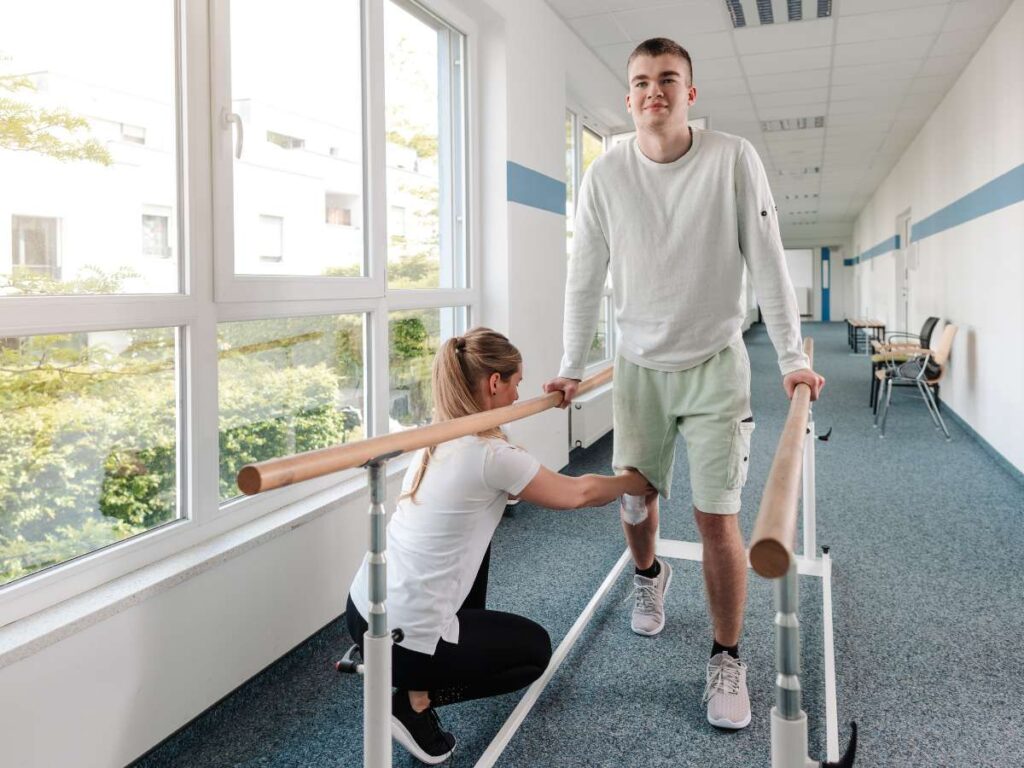
3. Ease of Use and Member Appeal
Once you’ve looked at how a machine works the body, it’s time to think about something just as important.
Will your members actually want to use it?
Because even the most powerful equipment isn’t helpful if it’s confusing or frustrating.
Learning Curve and User Interface
Let’s start with how simple each machine is for a new user.
In my experience, ellipticals win here. Most people can step on, press quick start, and go. The motion is smooth. The controls are easy to figure out—similar to recumbent bikes, which are designed to get members moving without complexity.
Stair steppers take a little more getting used to. You need balance. Some people feel nervous during their first try. Others push too hard and burn out quickly. I’ve seen more people ask for help on a stair stepper than an elliptical.
Now let’s talk screens.
Both machines now come with smart features:
- Touchscreen displays
- Heart rate tracking
- Guided workouts
- App connections like Zwift or Kinomap
Higher-end models usually offer more features but even basic ellipticals tend to have a cleaner, simpler layout than steppers.
That simplicity helps build confidence especially for beginners.
Motivation and Workout Variety
Keeping members engaged is part of the job. Nobody wants to do the same thing every day. So, how do these machines help with variety?
Ellipticals usually offer:
- Interval programs
- Hill climbs
- Fat burn modes
- Full-body motion options
Stair steppers can have built-in programs too, but the motion stays more repetitive. That can make workouts feel longer, especially without distractions.
Want to keep members focused?
Look for machines with:
- Adjustable resistance
- On-screen feedback
- Built-in entertainment like Bluetooth audio or tablet holders
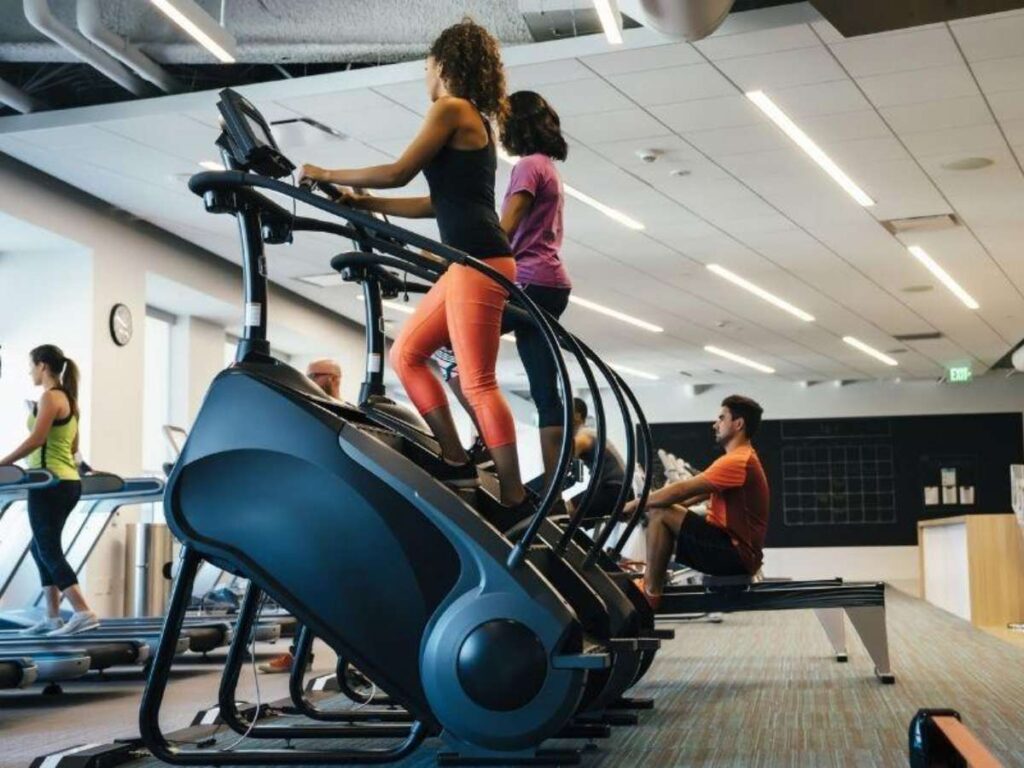
4. Floor Space and Installation Requirements
Workout experience matters. But so does where the machine fits. If you’ve ever tried to rearrange a packed cardio zone, you know how fast things get tight.
Choosing between a stair stepper and an elliptical isn’t just about performance. It’s also about how well it fits into your layout and whether it causes problems down the line.
Space Needed Per Unit
Let’s start with the footprint. Ellipticals usually take up more floor space lengthwise.
On average:
- Elliptical machine: around 6 to 7 feet long, 2.5 feet wide (1.8 to 2.1 meters by 0.75 meters)
- Stair stepper: smaller base, around 3 to 4 feet long, 2.5 feet wide (0.9 to 1.2 meters by 0.75 meters)
So if you’re short on floor length, a stair stepper might seem like a better choice.
But there’s a catch.
Stair steppers are taller. Most models need a ceiling clearance of at least 8 to 9 feet, especially if the user is tall. In some older gyms or basement setups, that becomes a problem fast.
I’ve made this mistake before. We installed a stepper in a room with low ceilings.
One member almost hit his head and we had to move the machine a week later.
So if you’re considering steppers, check your ceiling height first.
Accessibility and Traffic Flow
Next comes daily movement. Think about peak hours.
Will your machines block walkways? Will people be bumping into each other trying to get on or off?
In general:
- Ellipticals are easier to step onto, especially for older users
- Stair steppers require climbing up a bit, which can feel awkward in a tight space
Also, stair steppers usually stand taller. That can block sightlines in smaller gyms or studios.
5. Durability and Maintenance
After thinking through space and setup, there’s another question you can’t skip.
How long will the machine last and how much will it cost to keep it running?
Because breakdowns don’t just cost money. They frustrate your members, eat into floor space, and drain time you don’t have.
Common Wear Points and Repair Frequency
Every machine wears out somewhere. And if you’ve ever run a gym, you’ve probably dealt with at least one machine that seemed to be “in repair” more than it was in use.
With stair steppers, common issues include:
- Hydraulic resistance failures
- Step belts slipping or catching
- Motor noise over time
Most of the steppers I’ve owned needed a service call every 6 to 12 months. Some parts, like belts or shocks, needed replacing even sooner under heavy use.
Ellipticals break down too, but usually in different spots:
- Bearings
- Drive belts
- Pedal arm joints
I’ve had ellipticals last over 2 years before needing a major fix, especially when we kept up with basic cleaning and lube.
Maintenance Costs and Downtime
Here’s the part many people forget about: ongoing cost.
Technician visits can run $100 to $200 per call. And if you’re outside a major city? Add travel fees.
Parts can be slow to ship, too—especially for older models.
With steppers, I’ve had to wait weeks for specific resistance parts. That machine sat in the corner, taking up space.
Ellipticals tend to be easier. More brands. More shared components. And warranties often cover the basics for 1 to 3 years.
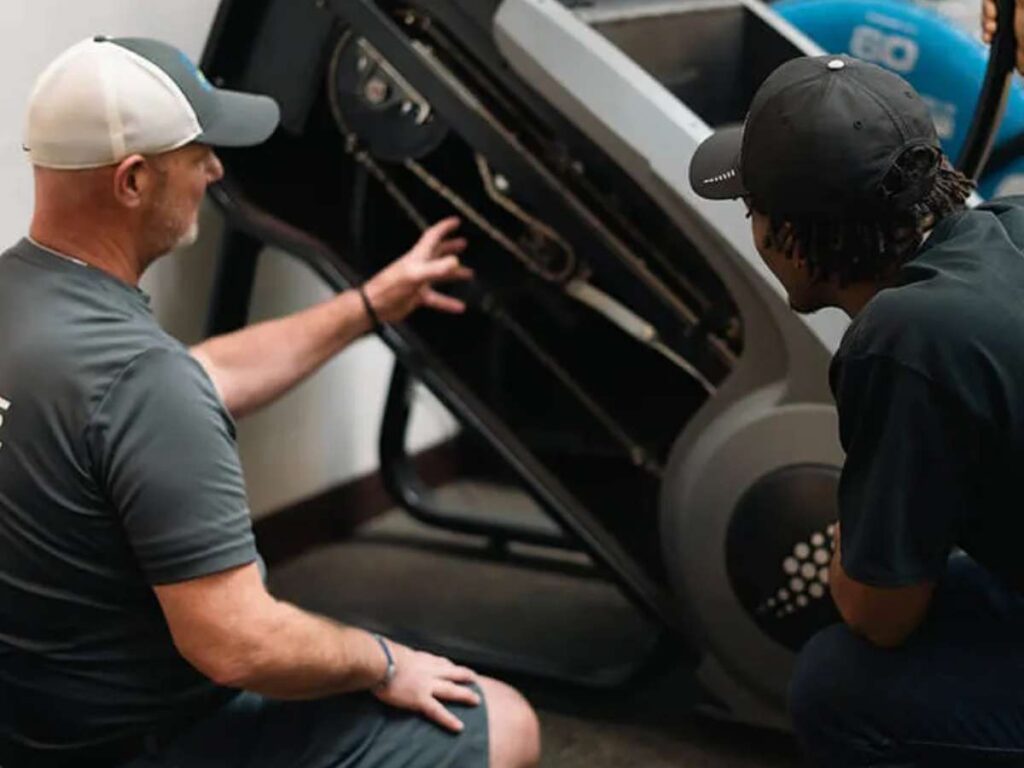
6. Member Demographics: Who Uses Which?
After thinking through maintenance, it’s worth looking at who your members are—and what they actually want from a workout. Because even the best machine won’t help if it doesn’t match the people using it.
Let’s start with age and fitness level.
Age Groups and Fitness Levels
In most gyms I’ve worked with, ellipticals are the go-to for:
- Older adults
- Beginners
- Anyone looking for a low-impact option
Why? The motion is smooth. There’s no hard pounding on the joints.
And people can start slow and build up over time.
I’ve seen new members, especially those returning after injury, head straight for the elliptical.
It’s less intimidating. They feel safer, and that helps them stick with their workouts.
Stair steppers, on the other hand, are more of a challenge. They attract:
- Intermediate and advanced users
- People focused on leg and glute toning
- Members who want high-intensity cardio in short bursts
I’ve noticed that people who already have a fitness routine often mix in the stair stepper for variety—or to level up their lower body training.
Now let’s talk about workout preferences across gender lines.
Gender and Workout Preferences
This isn’t a hard rule, but here’s what I’ve noticed:
- Many female members gravitate toward stair steppers for lower-body toning
- Male members often prefer ellipticals for steady cardio or warm-ups before weights
That said, your layout and machine choices can shape those trends too.
7. Price Range and Budget Considerations
After figuring out who will use the machines, the next step is thinking about what they’ll cost you—both upfront and over time.
Let’s start with the basics: initial price.
Initial Investment Comparison
Most ellipticals fall between $1,500 and $5,000, depending on features and brand. If you’re buying for a commercial gym, you’ll want one built to handle constant use. Those sit on the higher end of that range.
Stair steppers usually cost more upfront. You’ll often see them priced between $2,500 and $7,000 for commercial models.
Popular names in the commercial market include:
- Life Fitness
- Precor
- StairMaster
- Matrix
But the sticker price is just the beginning.
You’ll also need to budget for:
- Electrical requirements (especially for ellipticals)
- Replacement parts
- Maintenance service
- Extended warranties
I’ve bought machines that looked like a deal until the second repair call.
If you want to avoid that headache, it helps to buy from a company that knows commercial use inside and out.
YR Fitness builds cardio machines and gym equipment with the long run in mind. Our team works directly with gym owners to help you stay within budget without sacrificing quality.
Need a reliable quote or want help comparing options? We’re ready when you are.
Now let’s look at the costs that sneak up on you.
Hidden Costs
Ellipticals usually need a power source. That means planning your floor layout with outlets in mind.
You might also run into:
- Replacement parts
- Software updates
- Maintenance contracts
With stair steppers, I’ve paid more for technician visits. They’re complex machines. When something goes wrong, it’s rarely a quick fix.
Warranties vary. Some brands give a 1-year full warranty. Others break it down by parts—frame, electronics, labor.
8. Summary Table: Key Differences
We’ve covered a lot. Now, here’s a clear, honest summary to help you see everything side by side.
Category | Stair Stepper | Elliptical |
Size & Space | Shorter footprint, but taller. Needs 8–9 ft ceilings. | Longer footprint, lower height. Fits under 7 ft. |
Price Range | $2,500 to $7,000. | $1,500 to $5,000. |
Workout Focus | Targets lower body: glutes, quads, calves, hamstrings. | Full-body: legs, arms, core, glutes. |
Calorie Burn | High with steep resistance, but more intense. | Comparable or higher with less strain. |
Joint Impact | Tougher on knees and hips. | Low impact. Rehab-friendly. |
Learning Curve | Can feel awkward for beginners. | Easy to step on and start. |
User Base | Best for advanced users or short, intense cardio. | Great for beginners, older adults, and long sessions. |
Maintenance | Frequent: hydraulic repairs, belt issues. | Lighter: bearings and pedal joints. |
Lifespan | 4 to 6 years (heavy use). | 6 to 8 years or more with upkeep. |
Traffic Flow | Higher. Can block sightlines or walkways. | Lower. Smoother fit into floor plans. |
Conclusion
Are you thinking about ceiling height? Budget? Or how easy it’ll be to keep that machine running when the gym’s packed?
Whatever stood out, good. That means you’re paying attention to the right details.
Contact us today and let’s walk through each machine in depth now, so you can make a choice that fits your space, your members, and your goals.
Related articles:
